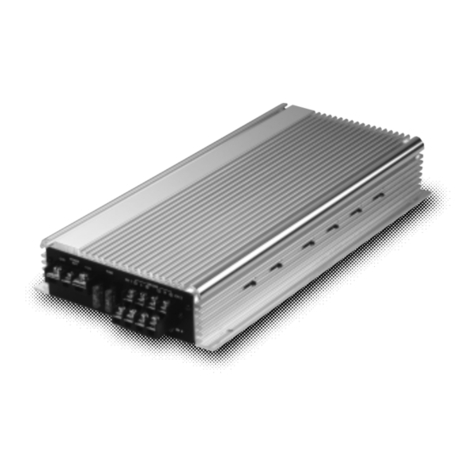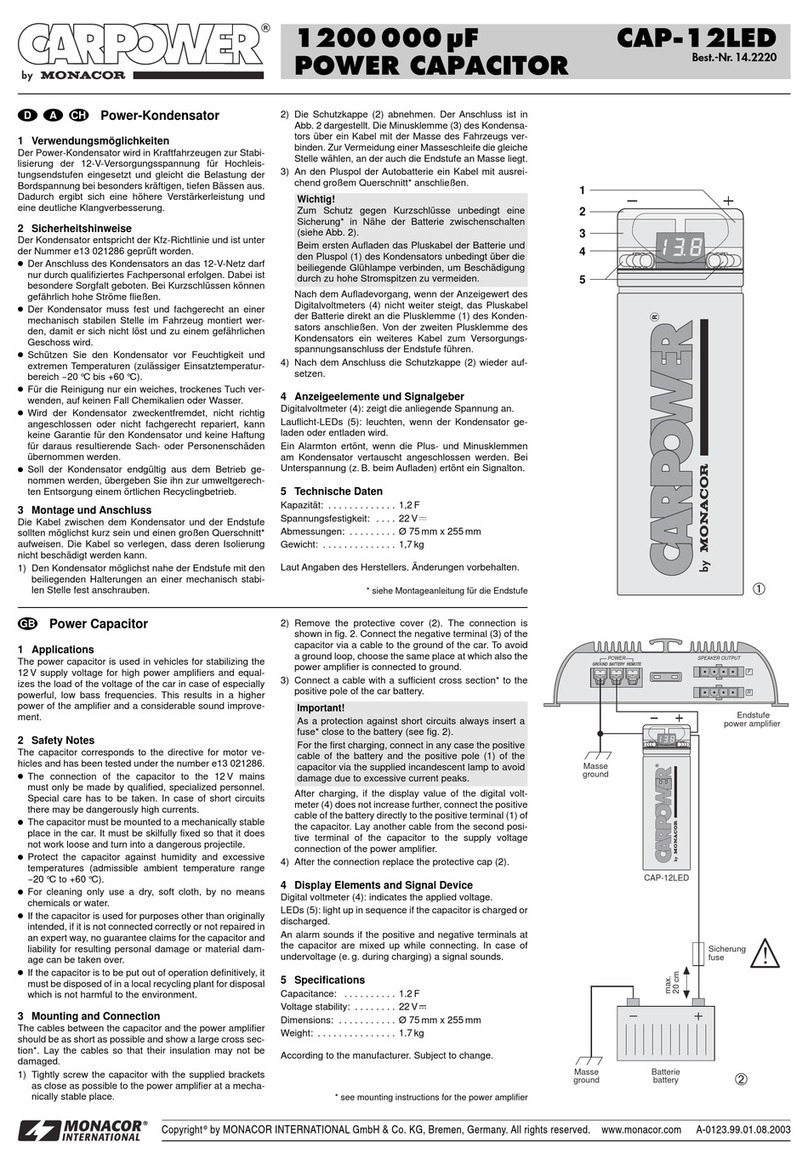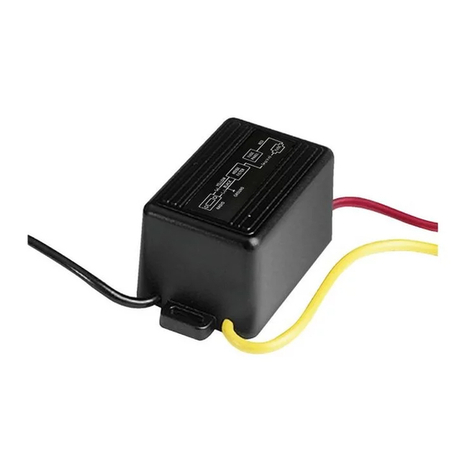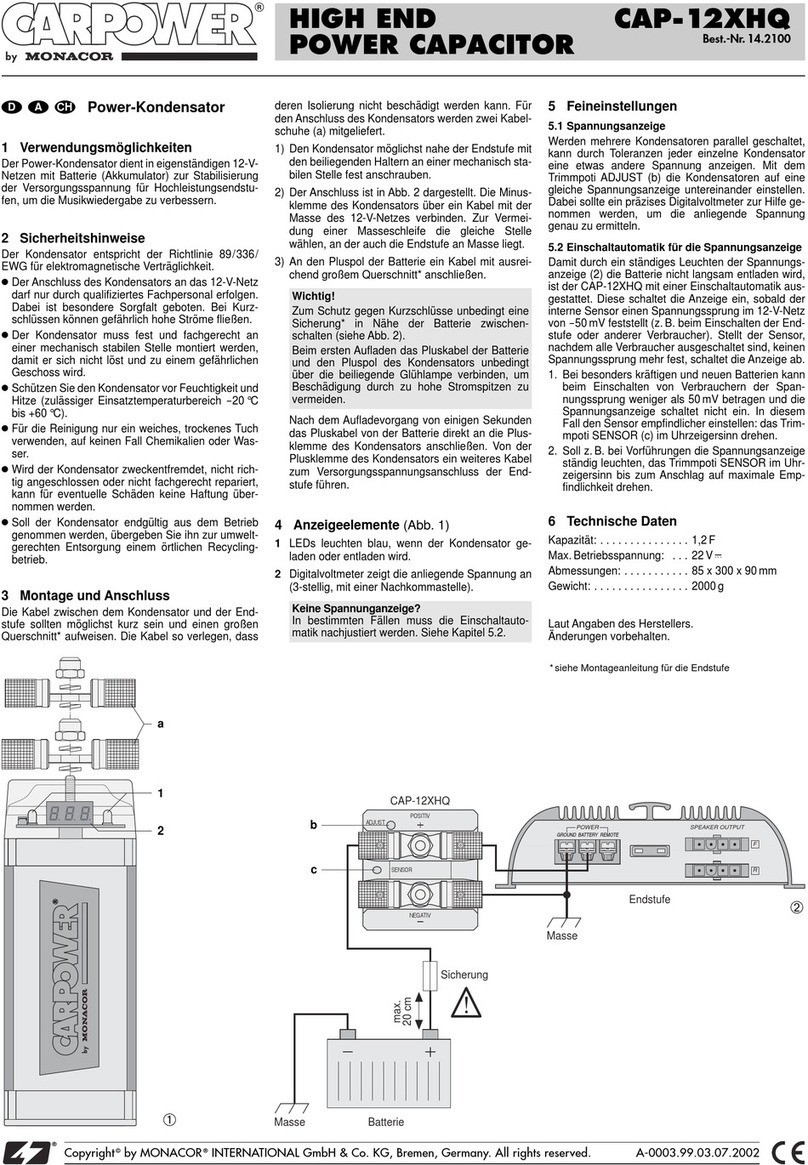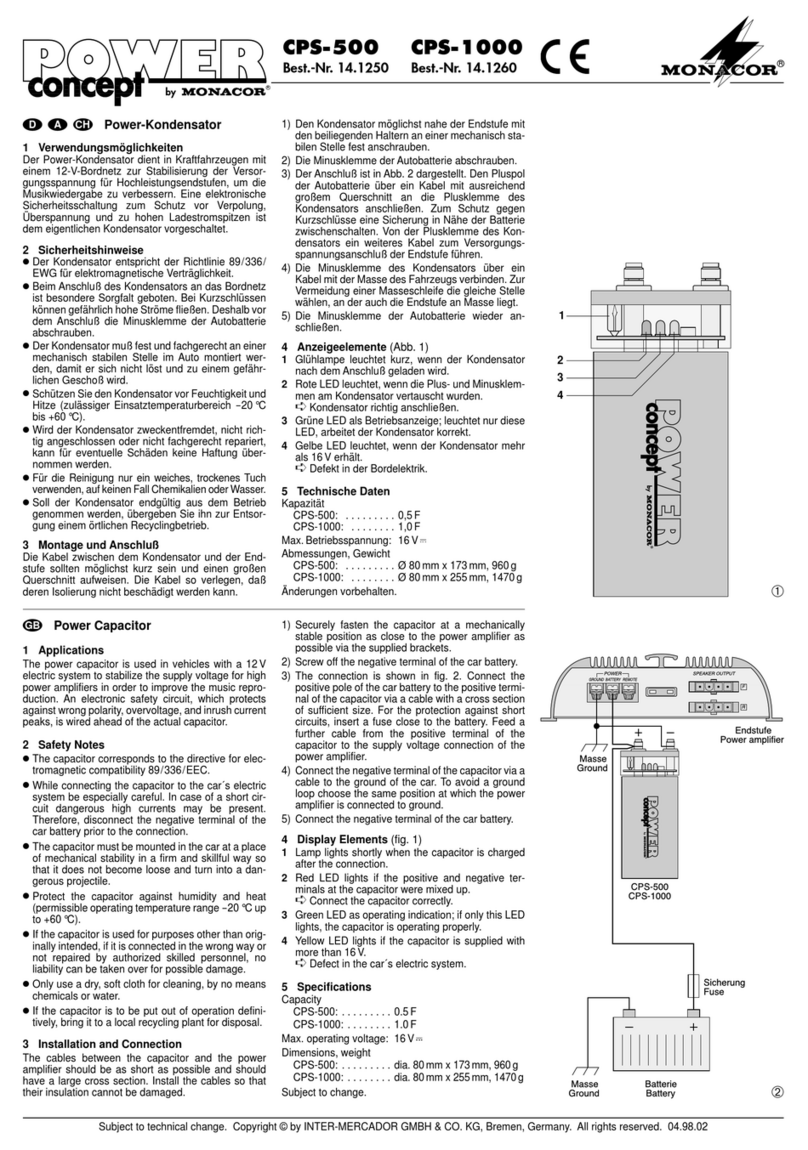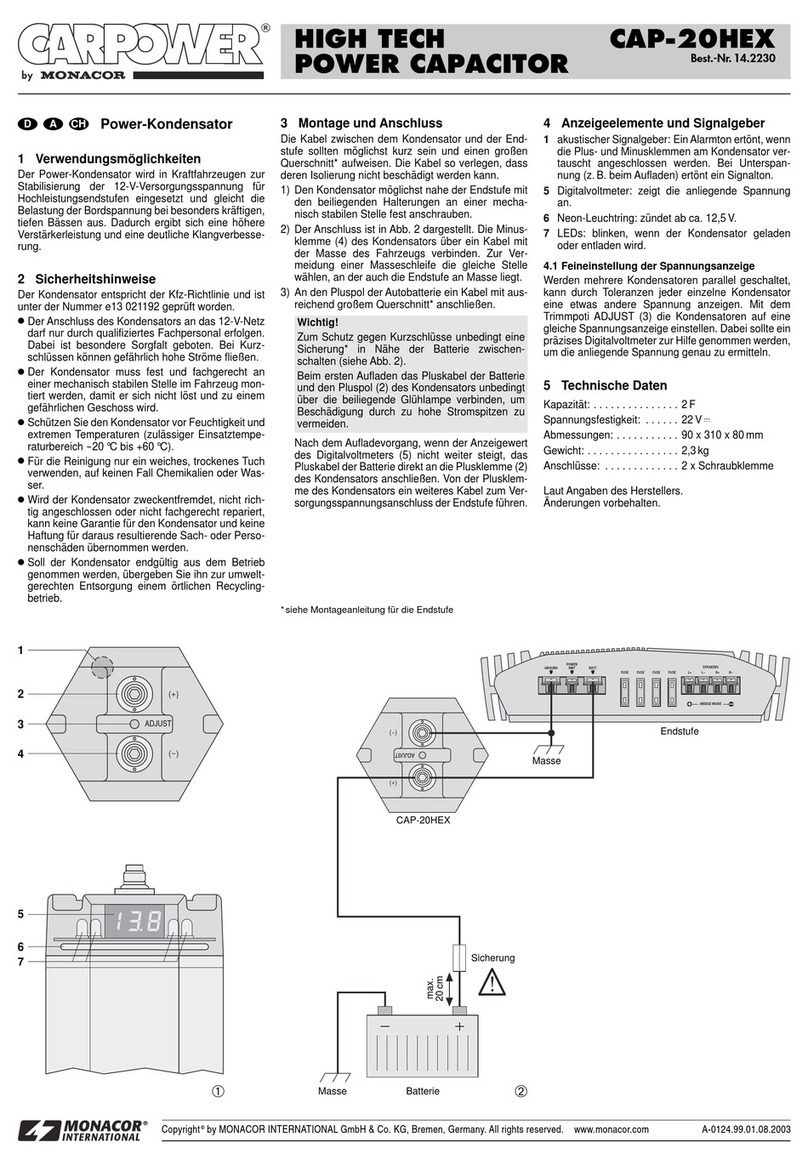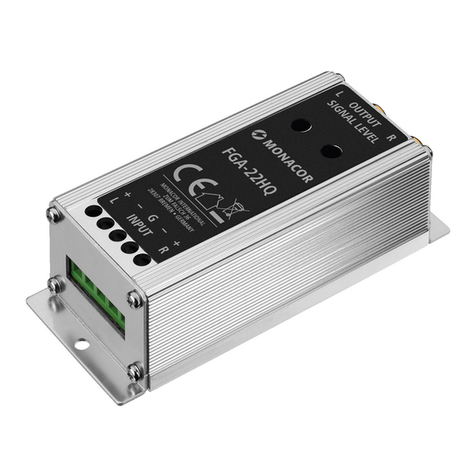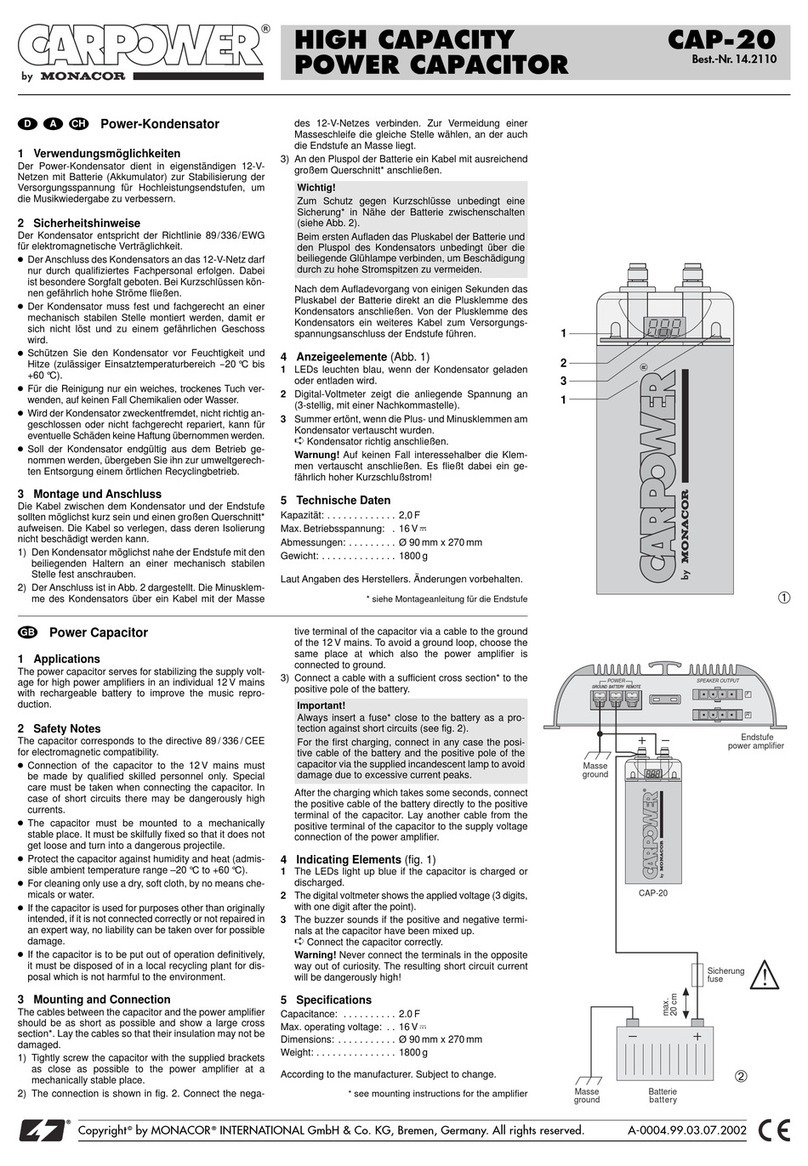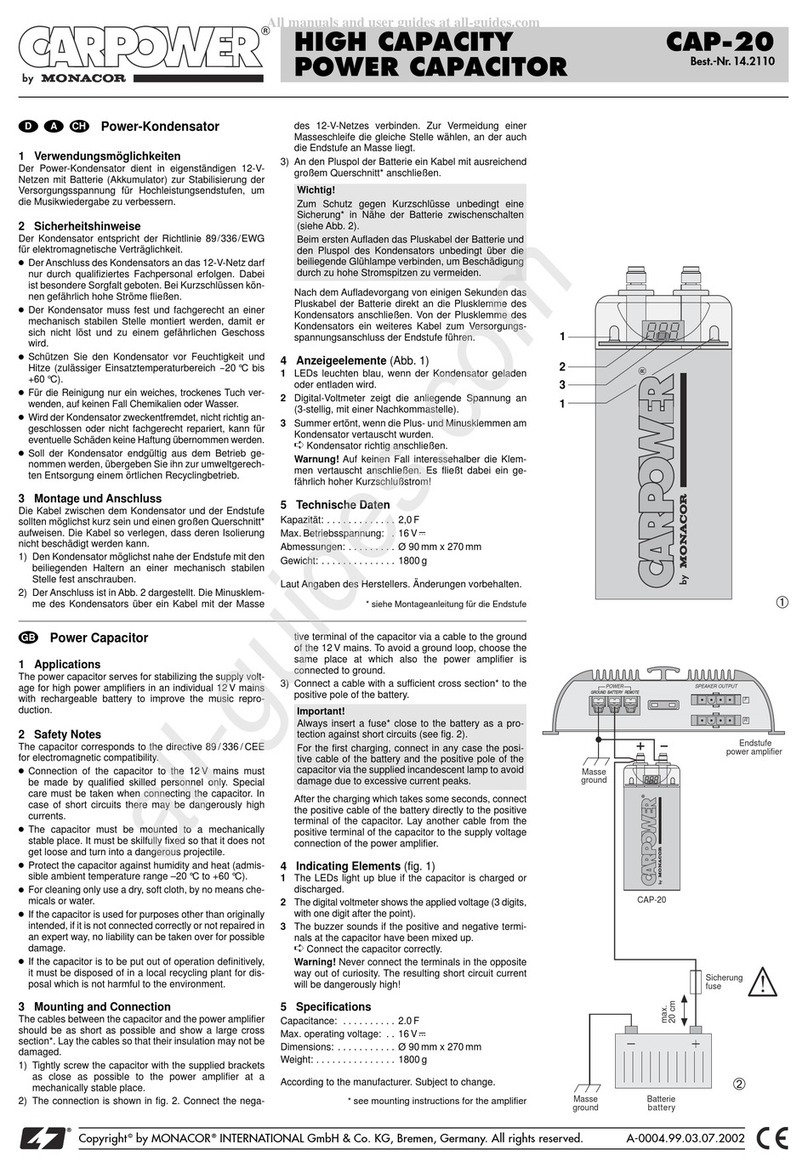Condensateur de puissance
Veuillez lire la présente notice avec attention avant lʼins-
tallation et conservez-la pour pouvoir vous y reporter ulté-
rieurement.
1 Possibilités dʼutilisation
Ce condensateur de puissance est utilisé dans des véhi-
cules pour stabiliser la tension dʼalimentation 12 V pour
des amplificateurs finaux audio et compense la charge
dans le cas de fréquences graves particulièrement puis-
santes. On obtient ainsi une puissance dʼamplificateur
plus importante et une amélioration distincte du son.
2 Conseils dʼutilisation et de sécurité
Le condensateur répond à toutes les directives néces-
saires de lʼUnion européenne et porte donc le symbole .
GProtégez le condensateur de lʼhumidité et de tempéra-
tures extrêmes (plage de température de fonctionne-
ment autorisée :
-
20 °C à +60 °C).
GPour le nettoyer, utilisez uniquement un chiffon sec et
doux, en aucun cas de produits chimiques ou dʼeau.
G
Nous déclinons toute responsabilité en cas de dommages
matériels ou corporels si le condensateur est utilisé dans
AVERTISSEMENT Le branchement du condensateur à
lʼalimentation 12 V du véhicule ne
doit être effectué que par un techni-
cien habilité. Il convient dʼêtre parti-
culièrement prudent. En cas de
courts-circuits, des courants élevés
peuvent circuler et être dangereux.
Le condensateur doit être monté de manière fixe et
appropriée, dans un endroit mécaniquement stable dans
le véhicule pour éviter quʼil ne se désolidarise de son
support et ne se transforme en projectile dangereux.
un but autre que celui pour lequel il a été conçu, sʼil nʼest
pas installé de manière sûre, sʼil nʼest pas correctement
branché ou sʼil nʼest pas réparé par une personne habili-
tée ; en outre, la garantie deviendrait caduque.
3 Installation
Les cordons entre le condensateur et lʼamplificateur
devraient être le plus court possible et dʼune grande sec-
tion*. Placez les câbles de telle sorte que leur isolation ne
puisse en aucun cas être endommagée.
1) Vissez fermement le condensateur aussi proche que
possible de lʼamplificateur avec les supports livrés (5).
2) Connectez une des deux bornes moins (2) du conden-
sateur via un câble, à la masse du véhicule. Pour éviter
tout bouclage de masse, choisissez le même endroit
que celui où se trouve la masse de lʼamplificateur.
3) Reliez un câble avec une section suffisamment grande*
au pôle plus de la batterie du véhicule.
Pour la protection contre un court-circuit], un fusible*
doit impérativement être intercalé à proximité de la
batterie (voir schéma ci-dessous).
Lors de la première charge du condensateur, reliez
impérativement le câble plus de la batterie à une des
bornes plus (1) via une lampe à incandescence 12 V
fournie : vous éviterez ainsi tout dommage causé par
des pointes de courant trop importantes.
Attention ! Si les pôles plus et moins du conden-
sateur sont inversés sur le condensateur, un signal
Lorsque le condensateur est définitivement retiré
du service, vous devez le déposer dans une
usine de recyclage de proximité pour contribuer à
son élimination non polluante.
4) Après le processus de charge, lorsque la valeur de lʼaf-
fichage (4) nʼaugmente plus, retirez la lampe et reliez le
câble plus de la batterie directement à la borne plus du
condensateur. Tirez un second câble dʼune des bornes
plus du condensateur vers la borne de la tension dʼali-
mentation de lʼamplificateur.
4 Indicateurs de tension et de fonctionnement
Les LEDs (3) bleues et lʼaffichage digital de tension (4)
brillent à partir dʼune tension de charge de 5,5 V environ.
clignote : tension < 9,2 V = sous-tension
…
clignote : . . . sous-tension mais la valeur est affichée
… : tension de charge mesurée
clignote : tension > 15,9 V = surtension
Si la tension ne se modifie pas, les indicateurs de tension
et de fonctionnement sʼéteignent après 2 minutes environ
pour par exemple nʼutiliser quʼun faible courant de la bat-
terie du véhicule lorsque le moteur est éteint. En cas de
modification de la tension, les affichages se rallument.
5 Caractéristiques techniques
Capacité : . . . . . . . . . . . . . . . . 1 F ± 10 %
Tension fonctionnement : . . . . 12 V
Tenue en tension : . . . . . . . . . . 20 V
Dimensions sans support : . . . ∅75 mm × 245 mm
Poids : . . . . . . . . . . . . . . . . . . . 1,5 kg
Tout droit de modification réservé.
sonore retentit. Débranchez immédiatement le câble
plus du condensateur !
Condensatore di potenza
Vi preghiamo di leggere attentamente le presenti istruzioni
prima dellʼinstallazione e di conservarle per un uso futuro.
1 Possibilità dʼimpiego
Questo condensatore di potenza serve negli autoveicoli per
stabilizzare la tensione dʼalimentazione di 12 V dei finali
audio. Riesce a compensare il carico in caso di bassi parti-
colarmente potenti, procurando in tal modo una maggiore
potenza dellʼamplificatore e un suono decisamente migliore.
2 Avvertenze di sicurezza
Il condensatore è conforme a tutte le direttive richieste del-
lʼUE e pertanto porta la sigla .
GProteggere il condensatore dallʼumidità e da temperature
estreme (temperatura ammessa fra
-
20 °C e +60 °C).
GPer la pulizia usare solo un panno morbido, asciutto;
non impiegare in nessun caso prodotti chimici o acqua.
GNel caso dʼuso improprio, di montaggio non sicuro, di col-
legamento sbagliato o di riparazione non a regola dʼarte
del condensatore, non si assume nessuna responsabilità
AVVERTIMENTO Il collegamento del condensatore con
la rete 12 V di bordo deve essere
fatto solo da personale qualificato.
Occorre procedere con particolare
cautela. In caso di cortocircuito ci
possono essere delle alte correnti
pericolose.
Il condensatore deve essere montato nei veicoli a regola
dʼarte e in un punto meccanicamente stabile per esclu-
dere che si stacchi diventando un proiettile pericoloso.
per eventuali danni consequenziali a persone o a cose e
non si assume nessuna garanzia per il condensatore.
3 Installazione
I cavi fra il condensatore e il finale dovrebbero essere pos-
sibilmente corti e presentare una grande sezione*. Instal-
lare i cavi in modo tale che il loro isolamento non possa
essere danneggiato.
1) Avvitare bene il condensatore il più vicino possibile al
finale servendosi dei supporti (5) in dotazione.
2) Con un cavo, collegare uno dei due contatti negativi (2)
del condensatore con la massa del veicolo. Per esclu-
dere degli anelli di terra scegliere lo stesso punto dove
anche il finale è collegato con la massa.
3) Collegare un cavo con sezione sufficiente* con il polo
positivo della batteria dellʼauto.
Come protezione in caso di cortocircuito inserire assolu-
tamente un fusibile* vicino alla batteria (vedi fig. in calce).
Per la prima carica del condensatore collegare asso-
lutamente il cavo positivo proveniente dalla batteria
con uno dei contatti positivi (1) inserendo una lampa-
dina di 12 V. In questo modo, la corrente di carica
viene limitata e si evita il danneggiamento per via dei
picchi di corrente troppo alti.
Attenzione! Se si scambiano i poli positivi e negativi
sul condensatore, viene emesso un segnale acustico.
Staccare subito il cavo positivo dal condensatore!
Se si desidera eliminare il condensatore definiti-
vamente, consegnarlo per lo smaltimento ad
unʼistituzione locale per il riciclaggio.
4) Dopo la carica, quando il valore indicato sul display (4)
non aumenta più, togliere la lampadina e collegare il
cavo positivo della batteria direttamente con il morsetto
positivo del condensatore. Da un altro contatto positivo
del condensatore portare un altro cavo verso il contatto
del finale per assicurare la tensione dʼesercizio.
4 Indicazioni della tensione e di funzionamento
I LED blu di funzionamento (3) e lʼindicazione digitale della
tensione (4) si accendono da una tensione di carica di
5,5 V circa.
lampeggia: Tensione < 9,2 V = tensione troppo bassa
…
lampeggia: . . . Tensione troppo bassa, ma il valore viene
indicato
… : . . Tensione di carica misurata
lampeggia: Tensione > 15,9 V = sovratensione
Se la tensione non cambia, lʼindicazione della tensione e
di funzionamento si spegne dopo 2 minuti circa per pesare
sulla batteria dellʼauto solo con una corrente ridotta, p. es.
in caso di motore spento. Se la tensione cambia, le spie si
riaccendono.
5 Dati tecnici
Capacità : . . . . . . . . . . . . . . . . 1 F ± 10 %
Tensione dʼesercizio: . . . . . . . . 12 V
Rigidità dielettrica: . . . . . . . . . . 20 V
Dimensioni senza supporto: . . ∅75 mm × 245 mm
Peso: . . . . . . . . . . . . . . . . . . . . 1,5 kg
Con riserva di modifiche tecniche.
Copyright©by MONACOR INTERNATIONAL GmbH & Co. KG, Bremen, Germany. All rights reserved. www.carpower.com A-1002.99.01.05.2009
®
1000 000 µF
POWER CAPACITOR
CAP-10T
Best.-Nr. 14.2750
I
F B CH
*vedi le istruzioni di montaggio del finale
